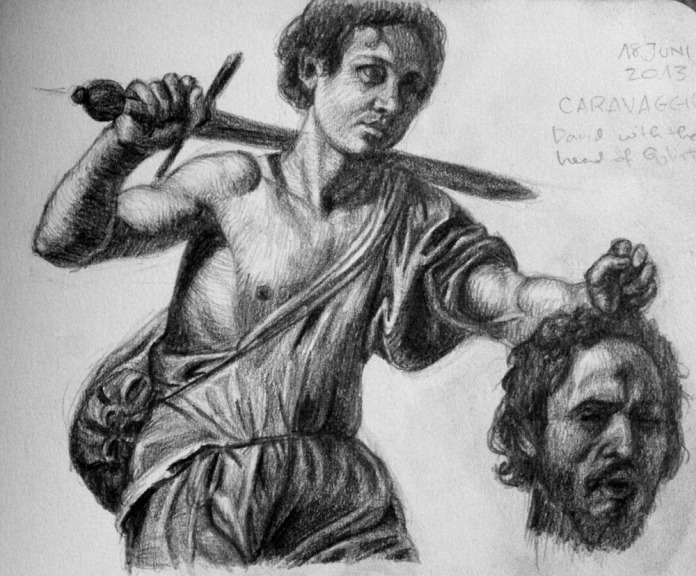Spending time with people who are not artists is always a reminder that what I do completely evades some people. While my private battles with representing different light sources is not going to fascinate everyone, there is a sense in which people who are not themselves painters want to engage with art, and some people who express such a desire also express being overwhelmed at how to go about this. As painters, we are aware of what Gombrich (in Kandel p. 189)* refers to as ‘the beholder’s share’—the impression that the viewer takes away from our work, the assumptions and education and experiences they bring to it. There comes a point where the work we have created leaves our hands and enters the minds and hearts of those inspecting it. Sometimes I wonder, though, whether we, as painters, ought not give a little thought to those people—try to give them a way in.
Painting is a visual art, and this fact leaves the modern Mensch at something of a loss when confronted with a flat, motionless piece of information. We are educated to digest all manner of written material, can swallow difficult philosophies through literary narratives, we can grasp emotional experiences through music. Painting asks something completely different of us, however, as I think Scott Breton very neatly sums up when he says, ‘In contrast to dance, one of the beautiful aspects of paintings is their immediacy as a whole, they exist all at once, as opposed to the temporal nature of writing, music or acted arts, allowing the viewer to wander and investigate the image in their own way.’
Our literary-based education seems to cut short of giving us any tools with which to engage with the visual. A smattering of magazine advertisement clippings and a few group discussions on symbolism is about all that some of us have been taught. I remember checking a huge illustrated volume of Carl Jung’s from the library at an early age. Others follow a stock-standard art history course through the modern epochs and are introduced to an assortment of historical and social contexts. And yet, there is far more to standing in front of a painting and systematically interpreting symbols as they pertain to a particular place and time, as though written in some logical code ready to be ‘read’ as any other text.
What goes unnoticed is that there is something important about demonstration and imitation in visual learning. We must teach each other curiosity, where our formal education has failed to. Things are not so much explained in art as simply presented, and we must learn to search them ourselves, and we must learn how to search them. We must learn to use our eyes not simply to register alphabets that give us prepared information, but to explore. And we must forget about even trying to express what we thus find in words.
How does one teach curiosity? It is certainly not mastered like any ordinary skill. By definition, you can’t pass a multiple-choice test with it, and you’d struggle to write a well-argued essay based on it because you would overturn more than you would resolve. Curiosity is not about getting the right answers, but about coming up with your own questions. For the painter, this can be much easier, because the questions can be of a very practical nature—why is this tone used here against this one? Why does this edge fade and not that one? How has that effect of distance been conveyed? How neutral does the skin pale in the shadows? And the act of drawing is a wordless questioning—a visual inquiry in response to visual information. Approaching a painting with a sketchbook and pencil and testing out the feel of the lines for oneself, imitating the flow and design of the image, tasting the contrast of light and shadow—in imitation one traces the very thoughts of the painter and gains insights that elude slippery eyes that skim the painting frantically in search of meaning.
There are several very simple experiences I will never forget that gave me such an insight into the type of visual curiosity that painting demands. The first was when Scott came to inspect a drawing I had just begun of a five-week long pose, after I had just got the guts of it on paper. ‘What is this drawing about?’ he asked me. I was at a loss, because I thought I would have to come up with some profound philosophical basis for my drawing, a rational epistemology, a grand unified theory. But Scott threw out some examples and demonstrated: it could be about the way the legs crossed over, or about the strength of the muscles in the back, or about the profile of the face, or about the twist in the torso. I felt such a sense of relief, because these were things I had considered, but hadn’t thought them ‘deep’ enough—because they were visual rather than intellectual things. And I was making a drawing after all, so it could be about purely visual things!
The second experience is really a series of experiences of poring over art books with Ryan. We would quietly sit and leaf through Sorolla, Degas, Lopez, Fechin. I wondered if I was seeing the ‘right’ thing. Ryan didn’t say anything, but sometimes he would trace his finger along the reproductions. I followed the slow arcs and tried not to overthink it, but just to sit before the painting and let my eyes slowly move over it. This is not something I was taught in art classes at school, when I read critical essays and searched for symbolism. No, now I was learning to see the painting itself. Soon, I could point to things too, and silent conversations arose between us. A combination of taking a rest from analytical thinking and of slowing down meant that I could respond to the visual aspects of the paintings. Actually, there is something in the crossing of limbs or the fall of drapery, just as there is something in the historical context and the feminist critique. If we could just stop feeling that our responses are too ‘simple,’ and if we could just give the painting room to breathe, we might see it.
The last was demonstrated to me by David Paulson in his life class. Paulson often teaches by doing, and will snatch up your pencil and usher you out of your seat so he can lay down some serious lines. And, most memorably, he doesn’t need to explain what he is doing. Rather, your eyes follow the movements of the pencil, and he bubbles with excitement at the best bits, saying repeatedly, ‘wow!’ It’s enough for those pencil sweeps to be seen and felt as wow moments, without needing to articulate why. The very mark articulates it. The mark describes the glorious thing that the eyes are enchanted by, and words can’t come close. And often that thing is the simple elegance of a form, of the bulge of a muscle, of the curve of a clavicle.
We are in such a hurry to understand, and falsely think that the slow and ponderous are dull-witted. We read clear and simple language in the hope that one pass will be enough to absorb the maximum information; this is a method of reading that is foreign to the philosopher, who mulls and gestates and chews, and shamelessly re-reads. Dog-eared passages and creased spines attest to the power of certain sections or turns of phrases; repetition cements ideas in the mind and fortifies memory; stacks of books must be returned to in order to cross-reference ideas. The truly curious student barely thinks in terms of ‘revision’ for her learning is a constant revisiting, refreshing, returning to old ideas in the context of the new. Learning is not linear like a course curriculum.
And yet the art gallery is populated by the frantic on a time-limit, armed with map and audio-guide, powering from room to room on a schedule. A sweaty, red-faced woman recently threw herself at me in anguish, thrusting her Kunsthistorisches map at me and wailing, ‘Do you know where the Breugels are? I’m never going to find them!’ The map is as meaningless to me, more a symbol of the incurious and time-poor—surely the curious will take the time to be surprised, to learn the gallery? Surely they will approach it without an agenda, and let their eyes be their only guide, and spend time with the works that sing to them like sirens, even if they don’t understand at first what draws them to them. Follow your eyes and the questions will begin to flow. And slow down enough to let them.
It’s hard to just look. To let the importance of the visual things really sink in, when we are searching for meanings that we can verbally express. It is a true gift, as a painter, to be permitted to look, purposefully, every day. I get to really be in the sunset every day, and to know it intimately. And it never, ever gets old. I begin to paint it, and the next day it is subtly different, and I see this slight change and appreciate it. Even if I think, ‘why couldn’t it have been this way yesterday when I painted that part?’ I can’t repaint it endlessly. And yet, if I do, there is only gain, as I ask myself endless questions and let curiosity rather than conclusions guide me.
The painter goes to the gallery and can stare for hours at shapes, lines and colours, seeing the power in the visual and not needing to enslave it in words, or situate it in history, or view it through a political lens. The painter humbly approaches the painting and lets the painting lead, and trusts his eyes, and wanders back and forth across the still terrain with the questions that slowly emerge. The painter isn’t pressured to ‘solve’ the painting, to ‘read’ it, or to ‘get’ it. The painting does indeed belong to a time period and have distinct cultural connotations, employs symbolism and draws on age-old traditions with all their spiritual and mythological foundations. But the painting is also the crafted response of a human being, with their own emotional response to these times and stories, with their own vision that they have tried to pass on to you. Slow down, trust your eyes, and let your eyes lead you. The questions will come; be brave enough to follow the questions rather than looking to authorities for answers.
* Kandel, Eric R. 2012. The age of insight: The quest to understand the unconscious in art, mind, and brain, from Vienna 1900 to the present. Random House: New York.
(p. 189) “The viewer interprets what he or she sees on the canvas in personal terms, thereby adding meaning to the picture. Riegl called this phenomenon the ‘beholder’s involvement’ (Gombrich later elaborated on it and referred to it as ‘the beholder’s share.’ “








